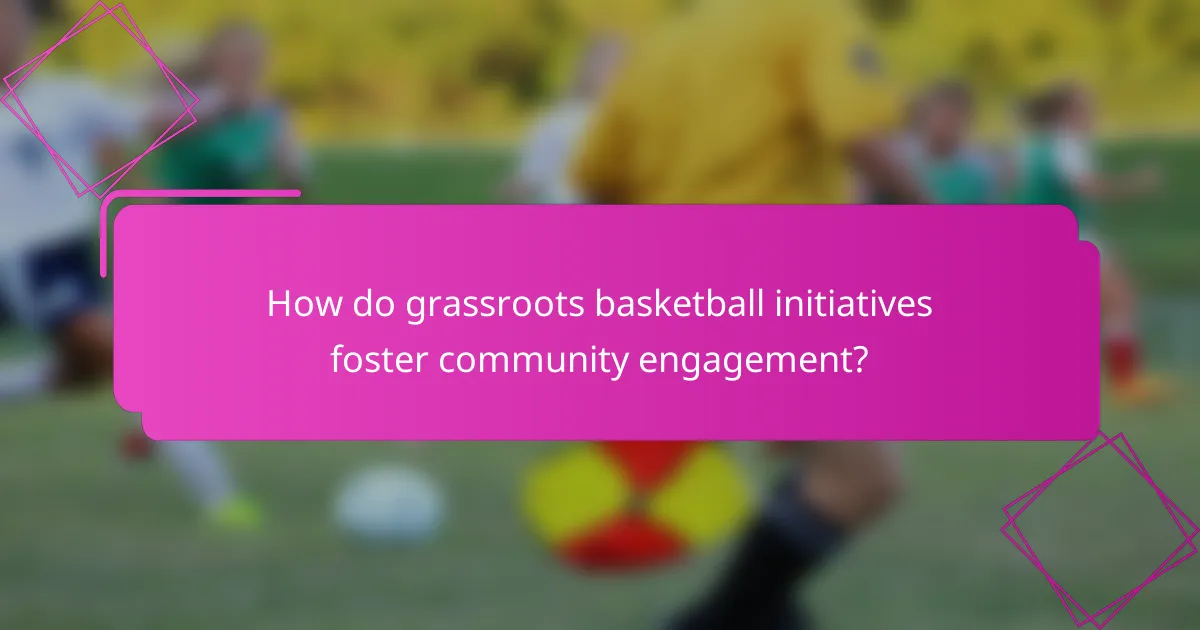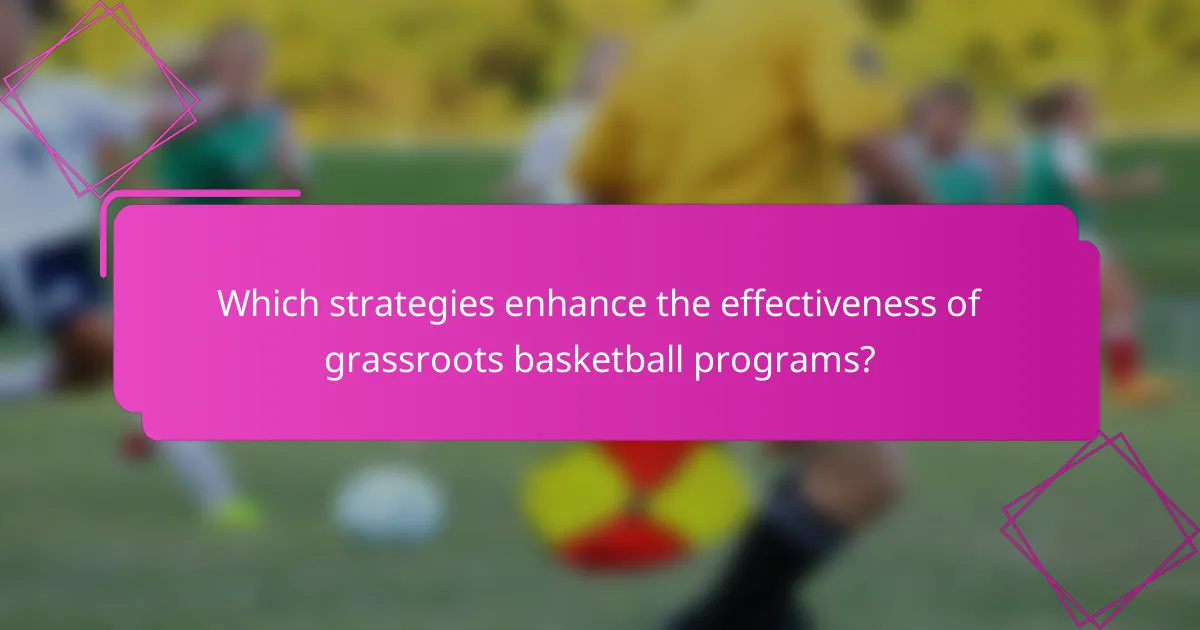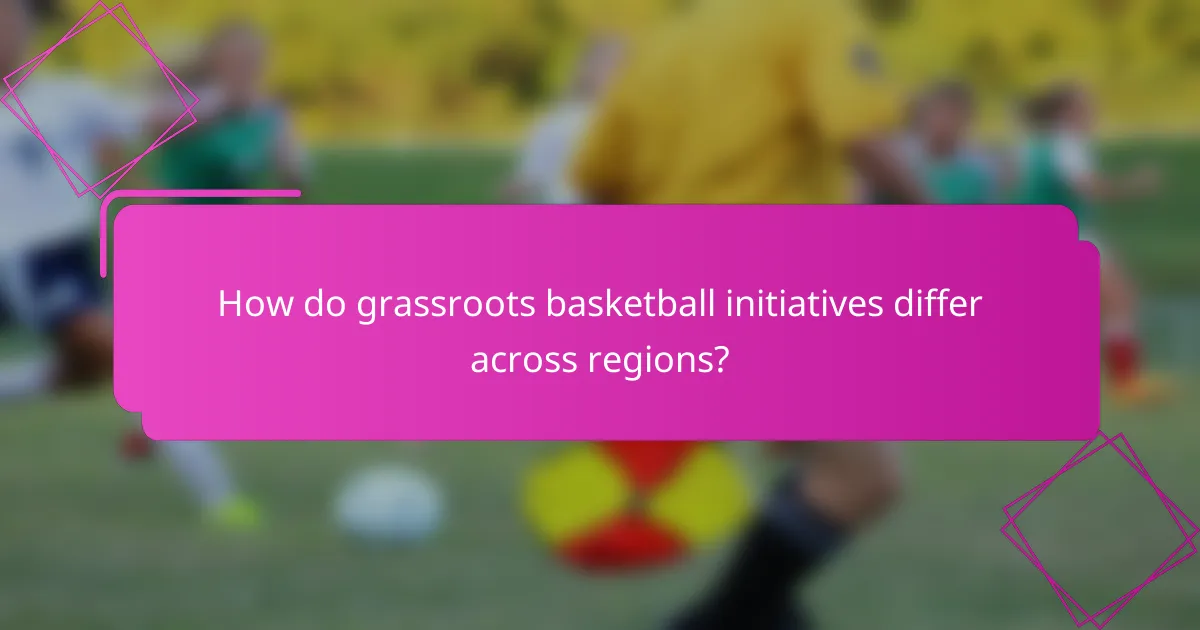Grassroots basketball initiatives play a crucial role in engaging youth through skill development, teamwork, and community involvement. These programs create inclusive environments that foster social interaction and healthy lifestyles. They also face challenges such as funding and community support, but effective strategies can enhance their impact. Understanding regional differences in these initiatives can lead to more tailored and successful programs.

How do grassroots basketball initiatives foster community engagement?
Grassroots basketball initiatives foster community engagement by creating inclusive environments that promote teamwork and social interaction. These programs often serve as platforms for youth to develop skills, build friendships, and gain confidence.
By providing access to sports, grassroots initiatives can reduce barriers to participation, ensuring that children from diverse backgrounds can engage in healthy activities. They encourage local involvement through volunteer coaching and organizing events, strengthening community ties.
Research shows that youth involved in sports are more likely to participate in community service and civic activities, demonstrating a commitment to their neighborhoods. This engagement not only benefits the individuals but also enhances overall community cohesion and pride.
Ultimately, grassroots basketball initiatives serve as vital tools for fostering positive relationships and empowering youth, creating lasting impacts on both personal and community levels.
What role do local organizations play in promoting youth participation?
Local organizations play a crucial role in promoting youth participation through grassroots basketball initiatives. These programs foster community engagement, enhance social skills, and provide mentorship opportunities for young athletes. They create safe spaces for youth to develop teamwork and leadership abilities, which are essential for personal growth. Additionally, local organizations often collaborate with schools and community centres, amplifying their reach and impact on youth engagement. By offering structured activities, they address social issues and promote healthy lifestyles among participants.
How do these initiatives address social issues in communities?
Grassroots basketball initiatives effectively address social issues by fostering youth engagement and community cohesion. They provide safe spaces for young people, promoting physical activity and teamwork. Programs often focus on mentorship, helping youth develop life skills and build positive relationships with peers and adults. These initiatives can reduce crime rates and improve academic performance by keeping youth off the streets and engaged in constructive activities. Additionally, they often target underserved communities, addressing disparities in access to sports and recreational opportunities.

What are the key benefits of grassroots basketball for youth?
Grassroots basketball provides numerous benefits for youth, including skill development, teamwork, and community engagement. These initiatives foster physical fitness and promote social interaction among participants.
1. Skill Development: Youth learn essential basketball skills, improving their coordination and athleticism.
2. Teamwork: Players develop collaboration skills, learning to work together toward common goals.
3. Community Engagement: Grassroots programs connect youth with local communities, fostering a sense of belonging.
4. Leadership Opportunities: Participants often take on leadership roles, enhancing their confidence and decision-making abilities.
5. Healthy Lifestyle: Regular participation encourages physical activity, contributing to overall health and well-being.
How does participation in basketball improve physical health?
Participation in basketball significantly improves physical health by enhancing cardiovascular fitness, strength, and coordination. Grassroots basketball initiatives engage youth, promoting active lifestyles and reducing sedentary behaviour.
Regular involvement in basketball can lead to improved heart health, with studies showing that players often exhibit lower resting heart rates. Additionally, the sport fosters muscle development, particularly in the legs and core, contributing to overall body strength. Coordination and agility are refined through the quick movements required in gameplay, which can translate to better athletic performance in other activities.
Moreover, these initiatives often emphasize teamwork and social interaction, which can boost mental health and emotional well-being. Engaging in such sports fosters a sense of community and belonging among participants, further encouraging sustained physical activity.
What impact does basketball have on mental well-being and social skills?
Basketball positively impacts mental well-being and social skills by fostering teamwork and resilience. Participation in grassroots basketball initiatives enhances youth engagement, promoting social interactions and emotional development. Studies indicate that regular involvement in sports like basketball can reduce anxiety and improve self-esteem. These initiatives also create a sense of community, allowing young players to build lasting friendships and develop essential communication skills.

Which strategies enhance the effectiveness of grassroots basketball programs?
Grassroots basketball programs enhance effectiveness through community engagement, skill development, and mentorship. Effective strategies include building partnerships with local schools, offering diverse training sessions, and creating inclusive environments.
Additionally, leveraging social media for outreach and showcasing success stories can attract more participants. Providing access to resources like coaching clinics and tournaments further strengthens these initiatives. Engaging parents and local businesses fosters a supportive network, increasing program sustainability.
How can partnerships with schools and local businesses strengthen initiatives?
Partnerships with schools and local businesses enhance grassroots basketball initiatives by providing resources, facilities, and mentorship. Schools can offer gym access and promote programs, while local businesses can sponsor events and provide financial support. This collaboration fosters community engagement and creates a supportive environment for youth. Moreover, such partnerships can lead to increased participation rates, with studies showing that community-backed programs see up to a 30% rise in youth enrollment. Engaging local stakeholders ensures sustainability and a broader impact on youth development.
What funding opportunities are available for grassroots basketball projects?
Various funding opportunities exist for grassroots basketball projects, including grants, sponsorships, and community fundraising. Organizations like the NBA Foundation and local sports councils often provide financial support. Additionally, crowdfunding platforms enable communities to raise funds directly. Some local governments may offer grants aimed at youth engagement in sports. Collaborations with businesses can also yield sponsorship deals that enhance project funding.

How do grassroots basketball initiatives differ across regions?
Grassroots basketball initiatives vary significantly across regions due to cultural, economic, and infrastructural differences. In North America, programs often emphasize skill development and competition, while European initiatives focus on community engagement and inclusivity. In developing regions, grassroots efforts may prioritize access to basic facilities and equipment.
For example, in urban areas of the United States, initiatives might partner with schools to enhance youth participation, leading to increased engagement in organized leagues. Conversely, in Africa, initiatives often involve local NGOs working to provide training and resources to underserved communities, fostering teamwork and discipline among youth.
These differences highlight the unique attributes of grassroots basketball initiatives, such as the focus on competitive play in some regions versus community-building in others. Understanding these variations can enhance the effectiveness of programs tailored to specific regional needs.
What unique challenges do urban programs face compared to rural ones?
Urban programs face unique challenges such as resource limitations, higher competition for youth engagement, and diverse community needs. These factors complicate implementation compared to rural initiatives, which often benefit from stronger community ties and fewer competing activities. Urban environments may struggle with access to facilities and funding, impacting program sustainability. Additionally, urban youth may experience higher levels of distraction and disengagement due to socio-economic factors, making effective outreach critical.
How does cultural perception influence youth engagement in basketball?
Cultural perception significantly shapes youth engagement in basketball by influencing attitudes, accessibility, and community support. Positive cultural associations with basketball can enhance participation rates among youth. For instance, in cultures where basketball is celebrated, local initiatives thrive, providing resources and mentorship. These grassroots programs often feature role models who resonate with the youth, fostering a sense of belonging. Additionally, cultural narratives around teamwork and perseverance in basketball can motivate young players to engage more deeply.

What metrics are used to measure the success of grassroots basketball initiatives?
Grassroots basketball initiatives measure success through various metrics. Key metrics include participation rates, skill development assessments, community engagement levels, and player retention statistics. These measurements help evaluate the impact on youth engagement and the overall effectiveness of the initiatives. For example, tracking the number of participants over time can reveal trends in youth involvement. Additionally, feedback surveys assess community perceptions and satisfaction, providing insights into program effectiveness.
How can participant feedback shape program development?
Participant feedback directly shapes program development by identifying strengths and areas for improvement. Engaging youth in grassroots basketball initiatives allows organizations to tailor programs to meet their needs effectively. Feedback can reveal preferences regarding training methods, scheduling, and community involvement. Additionally, it provides insights into the impact of initiatives on youth engagement, ensuring that programs remain relevant and effective. Collecting and analyzing this feedback fosters a responsive environment that encourages continued participation and growth in grassroots basketball.
What indicators reflect community impact and youth development?
Grassroots basketball initiatives positively influence community impact and youth development through enhanced engagement, skill development, and social inclusion. These programs foster teamwork, discipline, and leadership among young participants.
Key indicators of their impact include increased youth participation rates, improved academic performance, and enhanced life skills. For example, studies show that youth involved in sports are 1.5 times more likely to maintain higher grades. Additionally, community cohesion often improves as these initiatives bring together diverse groups, promoting social connections.
Moreover, unique attributes of successful grassroots programs include mentorship opportunities and access to resources. These aspects help cultivate a supportive environment where youth can thrive. As a result, communities experience long-term benefits, including reduced crime rates and increased civic engagement.

What are common pitfalls in implementing grassroots basketball initiatives?
Common pitfalls in implementing grassroots basketball initiatives include insufficient funding, lack of community support, and inadequate training for coaches. These factors can hinder youth engagement and program sustainability.
Inadequate outreach can result in low participation rates. Programs may also struggle with inconsistent scheduling, making it difficult for youth to commit. Limited access to facilities and equipment further exacerbates these challenges, restricting opportunities for skill development.
Effective grassroots initiatives require strong partnerships with local organizations to ensure resources and support. Engaging parents and community members fosters a sense of ownership and commitment to the program’s success.
How can programs avoid issues related to funding and resource allocation?
Grassroots basketball initiatives can avoid funding and resource allocation issues by building strong community partnerships. Collaborating with local businesses, schools, and nonprofits can create a sustainable support network. Additionally, diversifying funding sources, such as grants and sponsorships, enhances financial stability. Engaging volunteers fosters community investment and reduces operational costs. Implementing transparent budgeting practices builds trust and attracts more resources. Lastly, showcasing success stories can inspire further investment and participation in the initiative.
What strategies can mitigate challenges in participant retention?
Implementing community-building strategies enhances participant retention in grassroots basketball initiatives. Engaging youth through mentorship programs fosters relationships, while regular feedback sessions address concerns. Offering skill development clinics keeps players motivated and committed. Additionally, organizing community events strengthens bonds among participants and their families.
What best practices can enhance the sustainability of grassroots basketball initiatives?
Implementing best practices can significantly enhance the sustainability of grassroots basketball initiatives. Focus on community engagement, partnerships, and resource management to ensure long-term success.
Engage local communities by involving youth and families in decision-making processes. This fosters a sense of ownership and commitment to the program. Build partnerships with schools, local businesses, and organizations to secure funding and resources. Collaborate with stakeholders to create a network of support that enhances visibility and impact.
Utilize effective resource management by tracking funding, equipment, and volunteer contributions. Establish transparent processes to ensure accountability. Regularly evaluate program outcomes to identify areas for improvement and adapt strategies accordingly. This data-driven approach helps maintain relevance and effectiveness in meeting community needs.
